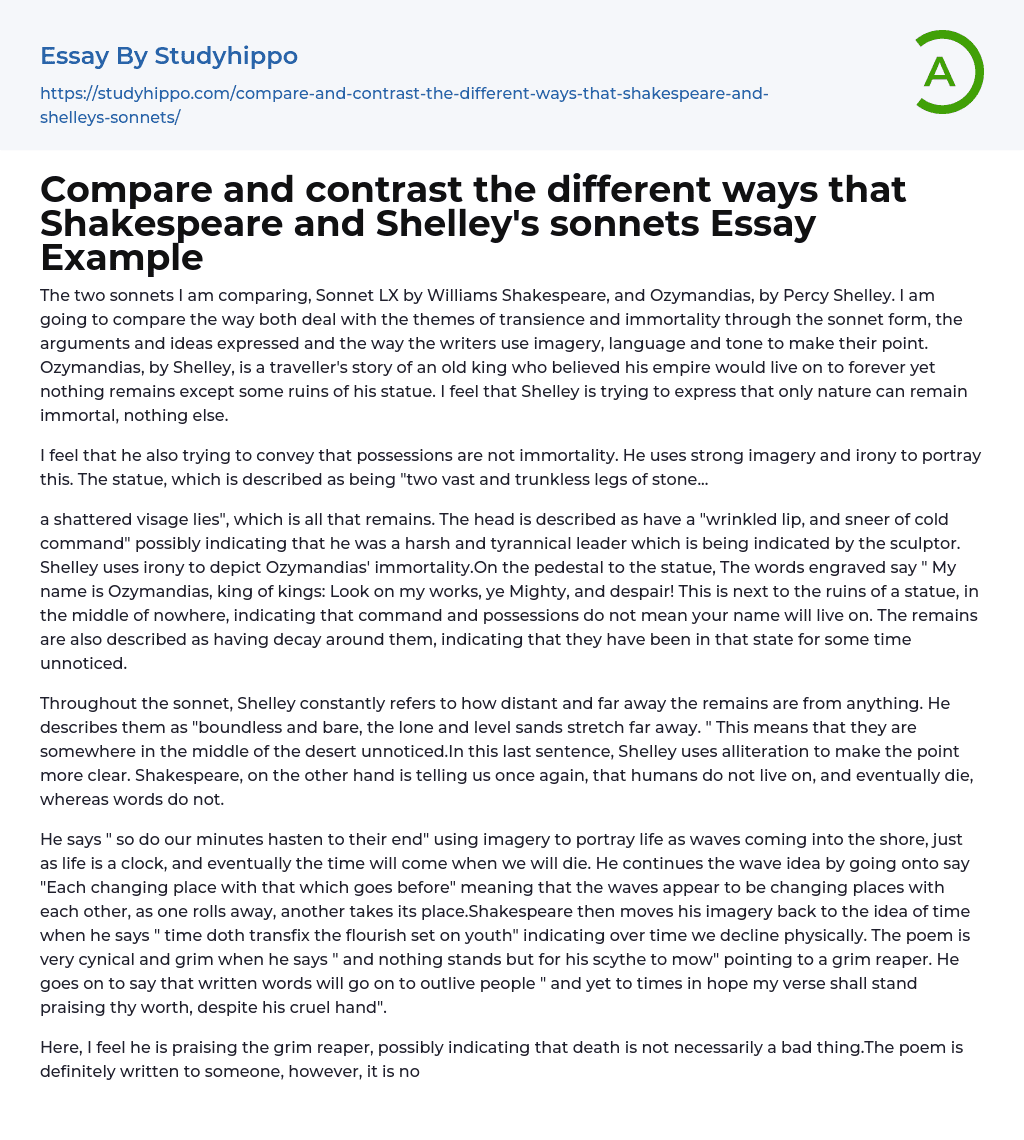

Compare and contrast the different ways that Shakespeare and Shelley’s sonnets Essay Example
The two sonnets I am comparing, Sonnet LX by Williams Shakespeare, and Ozymandias, by Percy Shelley. I am going to compare the way both deal with the themes of transience and immortality through the sonnet form, the arguments and ideas expressed and the way the writers use imagery, language and tone to make their point. Ozymandias, by Shelley, is a traveller's story of an old king who believed his empire would live on to forever yet nothing remains except some ruins of his statue. I feel that Shelley is trying to express that only nature can remain immortal, nothing else.
I feel that he also trying to convey that possessions are not immortality. He uses strong imagery and irony to portray this. The statue, which is described as being "two vast and trunkless legs of stone...
a shatte
...red visage lies", which is all that remains. The head is described as have a "wrinkled lip, and sneer of cold command" possibly indicating that he was a harsh and tyrannical leader which is being indicated by the sculptor. Shelley uses irony to depict Ozymandias' immortality.On the pedestal to the statue, The words engraved say " My name is Ozymandias, king of kings: Look on my works, ye Mighty, and despair! This is next to the ruins of a statue, in the middle of nowhere, indicating that command and possessions do not mean your name will live on. The remains are also described as having decay around them, indicating that they have been in that state for some time unnoticed.
Throughout the sonnet, Shelley constantly refers to how distant and far away the remains are from anything. He describe
them as "boundless and bare, the lone and level sands stretch far away. " This means that they are somewhere in the middle of the desert unnoticed.In this last sentence, Shelley uses alliteration to make the point more clear. Shakespeare, on the other hand is telling us once again, that humans do not live on, and eventually die, whereas words do not.
He says " so do our minutes hasten to their end" using imagery to portray life as waves coming into the shore, just as life is a clock, and eventually the time will come when we will die. He continues the wave idea by going onto say "Each changing place with that which goes before" meaning that the waves appear to be changing places with each other, as one rolls away, another takes its place.Shakespeare then moves his imagery back to the idea of time when he says " time doth transfix the flourish set on youth" indicating over time we decline physically. The poem is very cynical and grim when he says " and nothing stands but for his scythe to mow" pointing to a grim reaper. He goes on to say that written words will go on to outlive people " and yet to times in hope my verse shall stand praising thy worth, despite his cruel hand".
Here, I feel he is praising the grim reaper, possibly indicating that death is not necessarily a bad thing.The poem is definitely written to someone, however, it is not clear who. Although the poems seem relatively similar, in saying that no thing can be immortal, the two writers have completely different views. Shakespeare
was a Christian, and Shelley an atheist, which I feel stands out in their poems. For example, I feel when Shakespeare is writing, he is referring to the grim reaper as the devil, an opposite to god and a popular theory in Christanity. Shelley, however makes no comment to religion and I feel this is a key notion in comparing the two.
- Book Summary essays
- Metaphor essays
- Reader essays
- Rhyme essays
- Literary devices essays
- Villain essays
- Books essays
- Genre essays
- Literary Criticism essays
- Writer essays
- Protagonist essays
- Simile essays
- Poem essays
- Book Report essays
- Book Review essays
- Greek Mythology essays
- Plot essays
- Tragic Hero essays
- Coming of Age essays
- Play essays
- Rhetoric essays
- Rhetorical Question essays
- Translation essays
- Understanding essays
- Reason essays
- Character essays
- Letter essays
- American Literature essays
- Literature Review essays
- Utopia essays
- Poetry Analysis essays
- Dante's Inferno essays
- Between The World and Me essays
- Incidents in The Life of a Slave Girl essays
- Flowers for Algernon essays
- Myth essays
- Everyday Use essays
- Boo Radley essays
- Genesis essays
- Richard iii essays
- Alice in Wonderland essays
- On the road essays
- Ozymandias essays
- The Nightingale essays
- Holden Caulfield essays
- Animal Farm essays
- 1984 essays
- A Hanging essays
- Shooting An Elephant essays
- A Tale Of Two Cities essays



